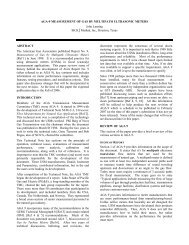Effects and Control of Pulsation in Gas Measurement
Effects and Control of Pulsation in Gas Measurement
Effects and Control of Pulsation in Gas Measurement
Create successful ePaper yourself
Turn your PDF publications into a flip-book with our unique Google optimized e-Paper software.
The compressor is caus<strong>in</strong>g the pulsation<br />
between 0 <strong>and</strong> 50 Hz, <strong>and</strong> a control valve is<br />
creat<strong>in</strong>g the pulse at 100 Hz.<br />
The measurement error referred to above is<br />
called Square Root Error (SRE). It is the<br />
calculation <strong>of</strong> unsteady flow us<strong>in</strong>g the square<br />
root <strong>of</strong> the average ∆P verses the average <strong>of</strong><br />
the square root values <strong>of</strong> the <strong>in</strong>stantaneous ∆P.<br />
Because SRE is directly related to flow<br />
measurement error, it is a very important topic<br />
to those who buy <strong>and</strong> sell natural gas.<br />
In a paper presented at the 1989 Gulf Coast<br />
<strong>Gas</strong> <strong>Measurement</strong> Short Course <strong>in</strong>-Houston,<br />
Texas titled "<strong>Pulsation</strong> <strong>Effects</strong> on Orifice<br />
Meter<strong>in</strong>g Consider<strong>in</strong>g Primary <strong>and</strong> Secondary<br />
Elements", Mr. Robert J. McKee <strong>of</strong> SWRI<br />
states, “a mathematical def<strong>in</strong>ition <strong>of</strong> SRE can<br />
be developed from the fact that the average<br />
flow is proportional to the Avg.√∆P as opposed<br />
to the √Avg. ∆P!'”<br />
The formula developed by SWRI to determ<strong>in</strong>e<br />
the severity <strong>of</strong> SRE is illustrated below:<br />
%SRE = (√Avg. ∆P - Avg.√∆P) x 100<br />
Avg. √∆P<br />
An illustration <strong>of</strong> a %SRE calculation <strong>of</strong> a series<br />
<strong>of</strong> six ∆P read<strong>in</strong>gs taken from a pulsat<strong>in</strong>g flow is<br />
shown below:<br />
Read<strong>in</strong>g ∆P’s (<strong>in</strong>.wc.) √∆P (<strong>in</strong>. wc.)<br />
1 75.0 8.660<br />
2 30.0 5.477<br />
3 47.5 6.892<br />
4 52.2 7.225<br />
5 26.1 5.109<br />
6 71.6 8.462<br />
Total: 302.4 41.825<br />
Avg.∆P: 50.4<br />
√Avg.∆: 7.099 6.971<br />
%SRE = (7.099 – 6.971) x 100 = +1.84%SRE<br />
6.971<br />
Note that %SRE is a positive number;<br />
mathematically it is impossible for %SRE to be<br />
2<br />
negative. In addition, %SRE <strong>in</strong>creases with pulsation<br />
amplitude, <strong>and</strong> is <strong>in</strong>versely proportional to ∆P (for a<br />
given pulsation amplitude %SRE will be greater at low<br />
∆P than at high ∆P).<br />
Other Primary Element Errors<br />
Though SRE is the largest component <strong>of</strong> pulsation<br />
<strong>in</strong>duced primary element error, under extreme<br />
pulsation conditions <strong>in</strong>ertial error <strong>and</strong> coefficient shift<br />
will both <strong>in</strong>crease <strong>in</strong> magnitude. A brief explanation <strong>of</strong><br />
each follows:<br />
Inertial Error: Pulsat<strong>in</strong>g gas flow will tend to rema<strong>in</strong> <strong>in</strong><br />
motion due to its <strong>in</strong>ertia. As a result, flow velocity<br />
changes lag beh<strong>in</strong>d ∆P changes. Inertial errors are<br />
<strong>in</strong>significant unless pulsation amplitude <strong>and</strong><br />
frequency are both relatively high.<br />
Coefficient Shifts: Though difficult to quantify, test<br />
data <strong>in</strong>dicates that pulsation levels above 1.5% SRE<br />
contribute to shifts <strong>in</strong> the orifice co-efficient.<br />
Measur<strong>in</strong>g %SRE<br />
When the %SRE at operat<strong>in</strong>g conditions is quantified,<br />
it can be used to approximate the primary element<br />
error <strong>in</strong>duced by pulsation <strong>and</strong> to determ<strong>in</strong>e whether<br />
or not corrective action is necessary.<br />
Percent square root error is measured with a device<br />
called the Square Root Error Indicator produced by<br />
PGI International. This analytical <strong>in</strong>strument utilizes a<br />
high frequency response ∆P transducer <strong>and</strong> special<br />
s<strong>of</strong>tware to calculate %SRE accord<strong>in</strong>g to the formula<br />
developed by SWRI shown earlier.<br />
The PGI SRE Indicator is an analytical <strong>in</strong>strument<br />
used to determ<strong>in</strong>e the severity <strong>of</strong> pulsation <strong>and</strong><br />
calculate %SRE. Because other primary element<br />
errors (<strong>in</strong>ertial error <strong>and</strong> co-efficient shifts) are not<br />
measured, %SRE should not be used to correct flow<br />
measurement read<strong>in</strong>gs, but to determ<strong>in</strong>e if corrective<br />
action is necessary.<br />
Reduc<strong>in</strong>g <strong>Pulsation</strong><br />
Because <strong>of</strong> the potential measurement error, many<br />
buyers will not accept delivery <strong>of</strong> natural gas from<br />
producers if the %SRE exceeds specific contract<br />
limits. %SRE allowed by contract may vary




